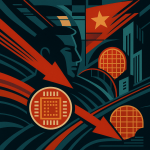Key Points
- The Moore Threads IPO on Shanghai’s STAR Market seeks to raise ¥8 billion RMB ($1.1 billion USD), making it the largest accepted on the STAR Market this year and the second-largest across all major Chinese stock exchanges.
- Founded in 2020, Moore Threads aims to dominate China’s AI chip market by developing independently developed, full-featured GPUs for AI, digital twins, and high-performance computing.
- The company shows impressive, rapid revenue growth (e.g., ¥438 million RMB in 2024) but has substantial net losses, although these are shrinking year-over-year.
- Moore Threads exhibits an extraordinary commitment to R&D, with R&D expenses in 2022 being 2422.51% of its revenue, indicating an aggressive strategy to build technological leadership.
- While there’s no single controlling shareholder, Zhang Jianzhong (张建中) effectively controls 36.36% of the company’s shares through direct holdings and various agreements.

The Moore Threads IPO is officially on the table, and it’s a big one, signaling a major move in China’s push for semiconductor independence.
Shanghai’s Sci-Tech Innovation Board, better known as the STAR Market, just greenlit the IPO application for Moore Threads Intelligent Technology (Beijing) Co., Ltd. (Mo’er Xiancheng 摩尔线程).
This is a huge deal.
Founded just in 2020, Moore Threads is going all-in on building a GPU empire from the ground up.
They’re not just another chip company; they’re focused on creating independently developed, full-featured GPUs.
Their target markets are the hottest sectors in tech right now:
- Artificial Intelligence (AI)
- Digital Twins
- High-Performance Scientific Computing
Essentially, they’re building the high-powered computing platforms that will run the next generation of tech in China.
The Nitty Gritty: A Breakdown of the Moore Threads IPO
Let’s look at the numbers, because they’re pretty staggering.
For its public debut, Moore Threads is looking to raise a massive ¥8 billion RMB ($1.1 billion USD).
This isn’t just a big number; it’s a record-setter.
As of today, this filing makes the Moore Threads IPO the largest accepted on the STAR Market this year.
It’s also the second-largest IPO accepted across all major Chinese stock exchanges (Shanghai, Shenzhen, and Beijing) for the entire year.
So, where is all that cash going?
The company has a clear, ambitious roadmap:
- Next-Gen AI Chips: Funding R&D for an integrated AI training and inference chip.
- Next-Gen Graphics Chips: Pouring capital into developing their next line of graphics chips.
- Next-Gen AI SoC: Building out a new AI System-on-a-Chip (SoC) project.
- Working Capital: Fueling the company’s day-to-day operations and growth.

Find Top Talent on China's Leading Networks
- Post Across China's Job Sites from $299 / role
- Qualified Applicant Bundles
- One Central Candidate Hub
Your First Job Post Use Checkout Code 'Fresh20'

Financials: Skyrocketing Revenue, Eye-Watering Losses, and Insane R&D Spend
Diving into the prospectus gives us a wild picture of a company in hyper-growth mode.
The revenue growth is impressive, but the burn rate is even more so.
Rapid Revenue Growth
The company’s top line is on a steep upward trajectory, showing strong market adoption.
- 2022: ¥46.0883 million RMB ($6.4 million USD)
- 2023: ¥124 million RMB ($17.1 million USD)
- 2024: ¥438 million RMB ($60.4 million USD)
But… The Losses Are Huge
Like many deep-tech startups, Moore Threads is deep in the red. Building cutting-edge GPUs is incredibly expensive.
However, there’s a positive trend here: the losses are shrinking year-over-year.
- 2022 Net Loss: -¥1.84 billion RMB (-$253.7 million USD)
- 2023 Net Loss: -¥1.673 billion RMB (-$230.7 million USD)
- 2024 Net Loss: -¥1.492 billion RMB (-$205.8 million USD)
An Unbelievable R&D Investment
This is where it gets really interesting.
Moore Threads is spending a mind-boggling amount on research and development relative to its revenue.
This is a classic “bet-the-company” strategy to win the technology race.
Check out these R&D expense ratios:
- 2022: 2422.51%
- 2023: 1076.31%
- 2024: 309.88%
Yes, you read that right. In 2022, they spent over 24 times their revenue on R&D.
This shows an aggressive, all-in commitment to building a technological moat.

ExpatInvest China
Grow Your RMB in China:
- Invest Your RMB Locally
- Buy & Sell Online in CN¥
- No Lock-In Periods
- English Service & Data
- Start with Only ¥1,000

Who’s Calling the Shots? A Look at Moore Threads’ Leadership Structure
So, who is in control of this high-stakes venture?
According to the prospectus, there’s no single controlling shareholder with more than 30% of the company’s shares.
However, there’s a clear leader.
Zhang Jianzhong (Zhang Jianzhong 张建中) is the de facto controller of the company.
Here’s how his control is structured:
- He directly holds 11.06% of the company’s shares.
- He has a “concerted action agreement” with two shareholding platforms: Nanjing Shen’ao (Nanjing Shen’ao 南京神傲) and Hangzhou Hua’ao (Hangzhou Hua’ao 杭州华傲).
- He also acts as the executive partner for three employee shareholding platforms, further consolidating his influence.
All in, Zhang Jianzhong effectively controls 36.36% of the company’s shares, giving him the final say on major decisions.
For anyone tracking the global semiconductor and AI industries, the Moore Threads IPO is a must-watch event that will reveal a lot about China’s tech ambitions and capital markets.
- Direct Shareholding: 11.06%
- Control via Concerted Action Agreement (Nanjing Shen’ao & Hangzhou Hua’ao): Yes
- Control via Executive Partner for Employee Shareholding Platforms: Yes
- Total Effective Control: 36.36%

Resume Captain
Your AI Career Toolkit:
- AI Resume Optimization
- Custom Cover Letters
- LinkedIn Profile Boost
- Interview Question Prep
- Salary Negotiation Agent






